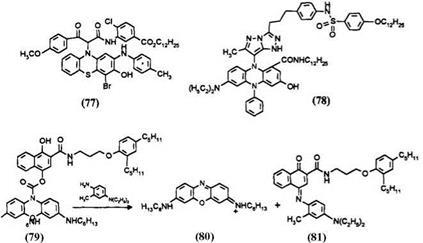Dye release developers are themselves colored molecules, the presence of which in silver halide photographic materials could interfere with light capture by the light-sensitive silver halide. Less light would be available to the sensitizing dyes. Another approach has been reported in which the leuco dye is linked to the coupling-off position of conventional photographic color
|
|
developers.25 The leuco dye developers obtained, illustrated by compounds 77, 78, and 79, would in theory be colorless. After light exposure and development with a jo-amino-phenylenediamine-type color developer, two dyes would be generated. The yellow leuco dye developer 77 would give rise to two yellow dyes whereas the magenta leuco developer 78 would generate two magenta dyes. The cyan leuco dye developer 79 would give rise to two cyan dyes 80 and 81, for example. Since two dyes are generated for every photon absorbed, this could form the basis for a method of image amplification. In practice, leuco dyes are not always colorless. Some leuco dyes retain a residual visible color, either yellowish or pinkish, which will add to the background. Image print-out due to premature air oxidation needs to be considered.
 25 июля, 2015
25 июля, 2015  Malyar
Malyar 
 Опубликовано в рубрике
Опубликовано в рубрике 